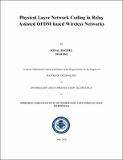Physical layer network coding in relay assisted OFDM based wireless networks
Abstract
Relays have the potential to support transmissions over long distance ranges, much more<p/>than what can be accomplished by relay-less wireless networks. The concept of network coding<p/>(NC) that was originally conceived for wired networks can also be used for efficient<p/>communication in wireless networks, owing to the ubiquitous nature of wireless transmissions.<p/>Earlier, NC was applied only to the higher layers of protocol stack. Only recently researchers<p/>have started exploring network coding at physical (PHY) layer in which, instead of bits, signals<p/>are combined. In literature, PHY layer NC is also referred as symbol level network coding. In<p/>this thesis, we considered performance evaluation of PHY layer NC scheme in OFDM based<p/>relay assisted wireless networks. Specifically, we conducted simulation study by implementing a<p/>canonical scenario consisting of three nodes, of which two of them constitute source and sink<p/>nodes and one of them would act as a relay. The OFDM based PHY layer that we used is similar<p/>to the one that is used in IEEE 802.11a standard. The relay node uses the popular decode and<p/>forward joint modulation (DF-JM) technique, which as the name implies decode and forward<p/>mechanism combined with joint encoding of data received from both the nodes. The<p/>performance of DF-JM has been compared with the conventional decode and forward (DF)<p/>technique. Our simulation results suggest that DF-JM based PHY layer NC outperforms the<p/>conventional DF scheme across different scenarios of interest. We also considered the<p/>performance of DF-JM scheme with relay selection and power allocation. Our simulation results<p/>suggest that an equal power allocation among various relays gives better throughput values as<p/>against that of the scheme where relay selection is combined with optimal power allocation. This<p/>behaviour is contrary to what was observed in a related work where simple analog relays were<p/>considered. The relatively better performance of the equal power allocation based DF-JM<p/>scheme can be attributed largely to the less number of transmission slots that a DF-JM based<p/>scheme would require, along with the diversity advantage of having all the relays transmit.
Collections
- M Tech Dissertations [923]

